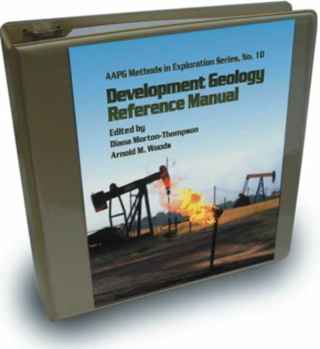Tool table
| Development Geology Reference Manual | |

| |
| Series | Methods in Exploration |
|---|---|
| Part | Wireline methods |
| Chapter | Basic tool table |
| Author | Mark W. Alberty |
| Link | Web page |
| Store | AAPG Store |
Logging tools are generally designed for operation under limited borehole conditions. A minimum hole size is the consequence of maximum tool diameter and pad curvatures, while maximum hole size is established by signal strength and caliper arm lengths. Mud types can affect signal transmission. Hole position affects signal strength and mud or borehole effects. Table 1 provides general operating limitations for the standard logging tools. Service companies have specially designed or modified tools that may allow extension of operation ranges.
| Tool | Minimum Hole Size (in.) | Maximum Hole Size (in.) | Mud Typeb | Preferred Hole Positions | Recommended logging speed (ft/hr) | ||||||
|---|---|---|---|---|---|---|---|---|---|---|---|
| F | S | B | K | O | Excentered | Stand-Off (in.) | Centered | ||||
| SP | — | — | √ | √ | √ | √ | × | √ | √ | √ | NA |
| Gamma ray | 6 | 20 | √ | √ | √ | √ | √ | √ | – | – | <1800 |
| Spectral GR | 6 | 20 | √ | √ | √ | NR | √ | √ | NR | – | <900 |
| Induction | 6 | 20 | √ | × | √ | × | √ | – | 1.5 | – | <3600 |
| Laterolog | 6 | 20 | × | √ | √ | √ | × | – | × | √ | <3600 |
| Microresistivity | 6 | 16 | √ | √ | √ | √ | × | – | – | √ | <3600 |
| Density | 6 | 16 | √ | √ | √ | √ | √ | √ | 0–2.0 | × | <1800 |
| IPL* | 6 | 16 | √ | √ | √ | √ | √ | √ | 0–2.0 | × | 1800 |
| Photoelectrical | 6 | 16 | √ | √ | × | √ | √ | √ | 0–2.0 | × | <1800 |
| Neutron | 6 | 16 | √ | √ | √ | √ | √ | √ | × | × | <1800 |
| Sonic | 6 | 20 | √ | √ | √ | √ | √ | – | – | √ | <3600 |
| FWS (monopole) | 6 | 20 | √ | √ | √ | √ | √ | × | × | √ | <1800 |
| Dipole | 6 | 14 | √ | √ | √ | √ | √ | – | × | √ | <1400 |
| Dipmeter | 6 | 22 | √ | √ | √ | √ | M | × | × | √ | <3000 |
| Formation tester | 6 | 16 | √ | √ | √ | √ | √ | NA | NA | NA | NA |
| FMS | 6 | 22 | √ | √ | √ | √ | × | × | × | √ | <1800 |
| Televiewer | 6 | 14 | √ | √ | √ | √ | √ | × | × | √ | <1200 |
| FMI | 6 | 21 | √ | √ | √ | √ | × | × | × | √ | <1800 |
| Pulsed neutron | 2 | 12 | √ | √ | √ | √ | √ | √ | – | – | <1800 |
| CMR* | 6.5 | 20 | √ | √ | √ | √ | √ | √ | – | – | 1800 |
aSymbols: √ = good conditions, × = unsuitable conditions, - = marginally acceptable conditions, NR = not recommended, NA = not applicable, M = with special modifications.
bMud types: F = freshwater (low salt), S = high salt, B = barite, K = high potassium salt, O = oil-based.
*Mark of Schlumberger
Computerized surface systems and cable communication systems have made tool combinations virtually unlimited. However, the combining of different tools into a single logging run may be limited by more than the physical ability to hook them together. Some devices are designed to operate excentered, some centered, and some stood off from the borehole wall. Tool positioning is important in ensuring valid environmental corrections. Table 1 includes optimum hole positions for each device. Caution should be used in combining a tool designed to be excentered, such as the neutron, with one designed to be centered, such as the sonic. The environmental effects upon the measurement may be uncorrectable. Also note that the maximum and minimum hole sizes are general recommendations only. Some logging devices are modified for larger and smaller holes.
See also[edit]
- Difficult lithologies
- Dipmeters
- Formation evaluation of naturally fractured reservoirs
- Basic open hole tools
- Determination of water resistivity
- Preprocessing of logging data
- Wireline formation testers
- Basic cased hole tools
- Standard interpretation
- Quick-look lithology from logs
- Borehole imaging devices